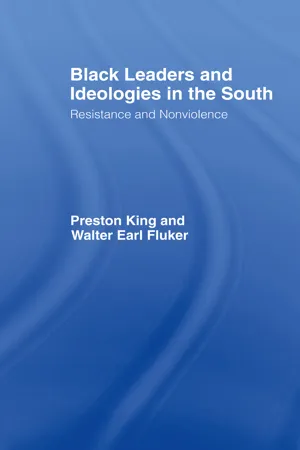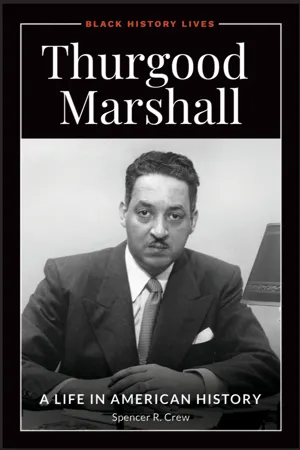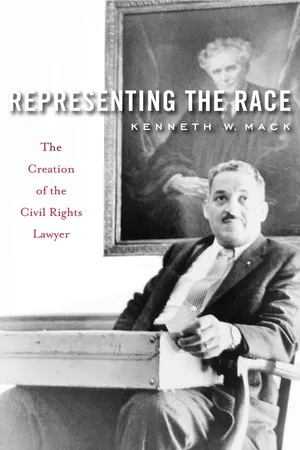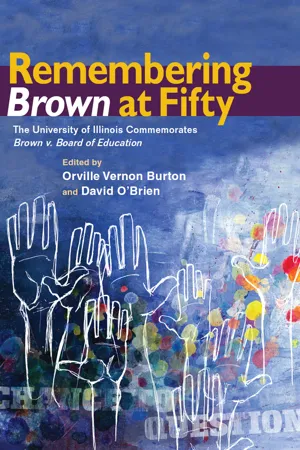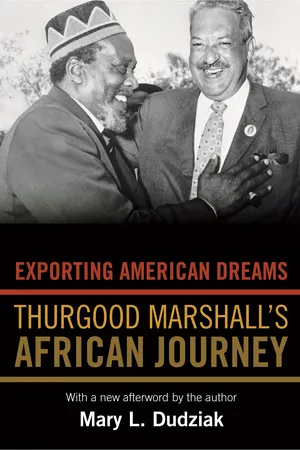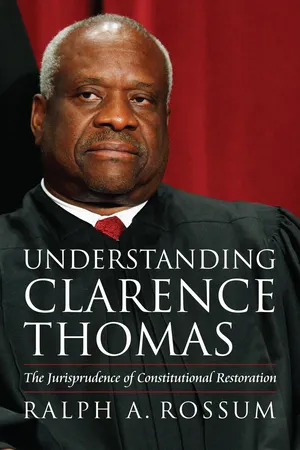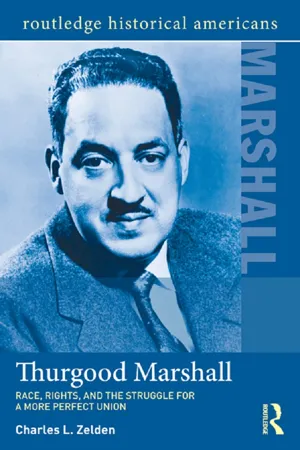History
Thurgood Marshall
Thurgood Marshall was the first African American to serve on the United States Supreme Court. Before his appointment, he was a prominent civil rights lawyer who successfully argued the landmark case Brown v. Board of Education, which led to the desegregation of public schools. Marshall's legacy includes his tireless efforts to advance civil rights and his significant impact on the American legal system.
Written by Perlego with AI-assistance
Related key terms
Related key terms
1 of 4
Related key terms
1 of 3
10 Key excerpts on "Thurgood Marshall"
- eBook - ePub
Black Leaders and Ideologies in the South
Resistance and Non-Violence
- Preston King, Walter Earl Fluker(Authors)
- 2013(Publication Date)
- Routledge(Publisher)
6Thurgood Marshall's Pursuit of Equality through Law
ADAM FAIRCLOUGH‘Probably the most important American lawyer of the twentieth century’ (Balkin 2001: 29), Thurgood Marshall personified both the strengths and limitations of using the courts as a means of establishing substantive equality between black and white Americans. As the principal architect of the epochal 1954 Brown decision, Marshall not only demolished de jure segregation in the South but also laid the groundwork for an attack upon racial inequality in the nation at large. His own career dramatically illustrated the political success of the civil rights movement. Born in 1908, he joined the staff of the NAACP Legal Defense and Educational Fund (LDF) in 1936, and headed that organisation between 1940 and 1961. Laying siege to the citadel of white supremacy, he not only breached its walls but entered the castle keep. Appointed Solicitor General in 1965, he joined the US Supreme Court two years later. He was the first African American to serve in either position. The outsider became the ultimate insider.Yet Marshall spent most of his 24 years on the Supreme Court fighting a conservative majority that possessed a cold, narrow, procedural view of the law that clashed with his own passionate conviction that the Court should be especially attentive to the rights of the poor, the powerless and the historic victims of discrimination. The black-robed justice, ostensibly one of the most powerful men in the land, wielded less influence than the poorly paid civil rights attorney who had been threatened by policemen, jailed and on more than one occasion almost lynched.For a man who had spent the first half of his career using the law as an instrument to promote equality, and with great success, this was a profound irony. As one of his law clerks wrote of these Supreme Court years, ‘Justice Marshall made a career of protesting the roll-back in school desegregation, the dismantling of procedural protections for the accused, the erection of new barriers to affirmative action, the disregard for free speech, and the reinstitution of the death penalty.’ For someone who was a man of action rather than a legal theorist, this impotence was excruciating. Anger crept into Marshall's later dissents. He lambasted decisions of the conservative majority as, in his own words, facile, myopic, disgraceful, arrogant and indecent (Fiss 1994: 52). - eBook - ePub
Thurgood Marshall
A Life in American History
- Spencer R. Crew(Author)
- 2019(Publication Date)
- ABC-CLIO(Publisher)
Baltimore Afro-American gave Marshall the lion’s share of the credit for the court victory while other African-American newspapers used the words “brilliant,” “resourceful,” and “dedicated” to describe him.Organizations outside of the African-American community also acknowledged Thurgood’s accomplishments. The Workman’s Circle, the largest Jewish fraternal labor organization, awarded Marshall their human rights award. Life magazine, which had followed his career closely, described Thurgood as “the chief counsel for equality.” Time magazine featured Marshall on its cover in September 1955. Consequently, Thurgood Marshall became a widely recognized national figure and a symbol of how unwavering dedication to a conviction could effect change.It was his success as a lawyer with the NAACP that brought Thurgood to the attention of Presidents Kennedy and Johnson. Both men understood his iconic stature among African Americans and civil rights supporters for his unwavering championing of equal rights. If they wished to make a statement illustrating their support of African Americans and legislation backing improved civil rights, appointing Thurgood to a prominent position in their administrations was a logical decision to make. A judicial appointment for a prominent lawyer like Thurgood made the most sense. President Kennedy appointed Thurgood to the Second Circuit Court, but for Johnson, the U.S. Supreme Court was where he believed Marshall belonged.The judicial appointments repositioned Marshall’s role with regard to civil and human rights legal issues. As a judge, he no longer brought cases to the courts hoping to convince them to rule in his favor. His conversations now were with other fellow justices as they conferred. Sitting on the bench, he had more direct impact on the final rulings they offered. This was an opportunity Thurgood embraced wholeheartedly. As a federal judge, Thurgood remained a staunch champion of civil and human rights. He took seriously the part of the judicial oath that obligated them to “administer justice without respect to persons, and do equal right to the poor and to the rich.” His record on the U.S. Supreme Court, in particular, reflected his commitment to this responsibility. - eBook - ePub
The Transition
Interpreting Justice from Thurgood Marshall to Clarence Thomas
- Daniel Kiel(Author)
- 2023(Publication Date)
- Stanford University Press(Publisher)
11JURIST OF THE CENTURYThe National Bar Association had no such controversy with Thurgood Marshall. Ten years earlier, the association gathered for its annual meeting in Washington, DC, in August 1988. Amid a five-day program of seminars and receptions was the association’s annual awards luncheon, at which the award for “Jurist of the 20th Century” was presented to Justice Marshall.12 The award was only the latest in a countless collection accumulated over decades. In contrast to Thomas, Thurgood Marshall’s pre-judicial career was defined by civil rights advocacy. Even before achieving fame for his victories at the Supreme Court, Marshall had been battling for human rights in local courtrooms, often where a Black defendant was on trial for his life. Indeed, Marshall biographer Gilbert King noted that in his early career, Marshall felt “the representation of powerless blacks falsely accused of capital crimes [was] his opportunity to prove that equality in courtrooms was every bit as vital to the American model of democracy as was the fight for equality in classrooms and in voting booths.” As his reputation grew, local African American citizens in small Southern towns would flock just to see him at work. “All they wanted to do—if they could—was just touch him, just touch him, Lawyer Marshall, as if he were a god,” recalled Alice Stovall, Marshall’s secretary at the NAACP.13He would go on to lead the legal assault on segregation, a campaign that turned him into a frequent presence at the Supreme Court in the 1940s and 1950s. He achieved victories in voting rights, housing rights, and, most famously, education. In 1944, he won the case Smith v. Allwright (1944), declaring the all-white primary unconstitutional; the following year, in Shelley v. Kraemer , he convinced the justices that covenants in housing deeds that prohibited African Americans from buying property were not constitutionally enforceable. Before the most famous triumph in Brown v. Board of Education in 1954, he led the NAACP’s effort in graduate school desegregation cases, including Sweatt v. Painter at the University of Texas law school, and McLaurin v. Oklahoma Board of Regents at the graduate school of the University of Oklahoma. In all, Marshall had won twenty-nine cases at the Supreme Court and dozens more in lower courts, a body of work that redefined the American Constitution and its relation to African Americans. The work earned him the nickname Mr. Civil Rights, and John Lewis called him a Founding Father of the New America. Even if he had never become a judge, in Marshall’s legal practice, he perhaps did more to transform constitutional law than any other lawyer in American history.14 - eBook - ePub
- Kenneth W. Mack(Author)
- 2012(Publication Date)
- Harvard University Press(Publisher)
5 Young Thurgood Marshall Joins the Brotherhood of the BarTHURGOOD Marshall’s life as a lawyer is preserved in American memory as a story that moves quickly from the beginning of his law practice in Baltimore in 1933, to his first major civil rights case two years later that desegregated the University of Maryland’s law school, and then to his move to New York to work for the NAACP on the litigation that would lead to Brown v. Board of Education. His life as a young lawyer struggling to build a reputation in Baltimore evokes little interest, save as an example of his neglect of, and lack of interest in, the ordinary work of an attorney in private practice. Yet Marshall’s Baltimore practice files, long available to researchers but little used, paint a picture of a lawyer who was about as successful in drumming up clients as contemporaries like Dallas Nicholas. Like his fellow Howard graduate Nicholas, Marshall set up his practice in one of the city’s two black lawyer enclaves, at 4 East Redwood Street. Like Nicholas and so many of his contemporaries, he made his living mostly in office practice—small business affairs, divorces, real estate, probate, and similar matters. Like them, he held down a side job to make ends meet. Marshall worked part time as a government clerk. For the most part, his private practice was a typical one for black lawyers in places like Baltimore and Washington, D.C., straight through the 1950s.1What set Marshall apart was his ability to do something most of his contemporaries could not—get into court in a few high-profile cases that made his reputation on both sides of the color line. Marshall came to prominence as a lawyer because, for blacks and whites alike, he seemed to represent something much larger than himself. White lawyers and judges tended to see the young, confident, impeccably trained black lawyer as someone much like themselves. Black Marylanders did, too. The authentic representative of African Americans in the courts, both groups told themselves, was a black lawyer who seemed as much like his white colleagues as possible. But each group wanted something different from the youthful lawyer whose presence in court seemed so disruptive of local racial mores. White lawyers seemed to desire, most of all, a person who could explain to a skeptical black public that the legal system treated them fairly. Blacks seemed to want an African American lawyer whose acceptance by whites gave him the power to call out racial inequity in the system. Marshall walked a fine line in his early years in practice, and the key to his success as a civil rights lawyer was his ability to convince each group that when he stepped into the courtroom, he represented its particular point of view. It was a paradoxical position, but that balancing act was the foundation for the stunning victories that marked his early years as a lawyer, including the one that desegregated the University of Maryland’s law school. - eBook - ePub
Remembering Brown at Fifty
The University of Illinois Commemorates Brown v. Board of Education
- Orville Vernon Burton, David O'Brien, Orville Vernon Burton, David O'Brien(Authors)
- 2022(Publication Date)
- University of Illinois Press(Publisher)
Brown. In due course he would leave the Legal Defense Fund and become a judge on the second circuit of the United States Court of Appeals. Later, President Lyndon Johnson sent him to the Department of Justice to become solicitor general of the United States. I do not know how much credence to put to the claim, ascribed to President Johnson, that since he intended to appoint Marshall to the Supreme Court, he wanted to be certain that he had adequate experience in the federal judicial system. True or not, President Johnson appeared to derive much pleasure from making the spectacular and historic appointment of Thurgood Marshall to the position of Associate Justice of the United States Supreme Court in 1967. This would be the first time that an African American had been appointed to such an exalted position. Marshall would sit on the Court until 1991.Although we would speak by telephone from time to time, I never saw Thurgood after he went to the high court. Whenever we visited over the telephone, I made myself available to share my opinion or assistance about any matter he desired; and I provided him with whatever historical information he sought. On one occasion, he called to request some citations for something on which he was working. I had learned not to inquire about the context of the citation he was seeking or, indeed, what case he was working on. When I provided him with the citation, he thanked me and was about to end the conversation without an exchange of the usual pleasantries that had been a part of our relationship in the past. When I asked him why he was so glum, he replied in a straightforward way that, if I knew what he knew, I would be glum too. When the decision came down in the case of Regents of the University of California v. Bakke, I wondered if it was the debate in the Court’s chambers that made Marshall so down. The Court held that in considering applicants for admission to the University of California at Davis, the university could take a variety of factors into consideration that, indeed, could outweigh the matter of race, thus not guaranteeing the admission of any African American to the university.He could have been unhappy about yet another development. Thurgood and his colleagues, including Charles Houston and the legal generation immediately preceding Thurgood, had risked their lives repeatedly by urging African Americans to vote, by urging aggrieved African Americans to use the courts and other legal instruments to protect their rights as citizens. Yet, since the Montgomery bus boycott, the Selma Voting Rights March, and the March on Washington, few gave any attention to the risks and sacrifices that the Houstons and the Marshalls had made in the earlier years. It was as though the pioneers had been forgotten and the focus was permanently on the later, more “glamorous” generation. Perhaps Thurgood paid little attention to what was occurring in the streets and on the hustings. It was just as well if he did not. By the time he had settled in as an associate justice of the United States Supreme Court, the civil rights battle had entered an entirely new stage. - James Anderson, Dara N. Byrne(Authors)
- 2008(Publication Date)
- Trade Paper Press(Publisher)
Fifty years ago, when Thurgood Marshall argued before the U.S. Supreme Court for an end to segregated schools, he made a simple case for simple justice. At six feet, three inches tall, Marshall was a big, chainsmoking man in his mid-forties who smiled even as he presented the case before the Supreme Court. Thurgood Marshall was committed to fighting segregated schools because he knew their consequences firsthand. When Marshall was born in 1908, black schools, without exception, had far fewer resources than rival white schools. The black teachers in the black schools were paid less than the white teachers in the white schools, and a diploma from the black schools was viewed as second-rate.When Marshall stood before the Court to insist on a black child’s right to attend any public school, he equated quality schools with integrated schools because the whites-only schools always had the best facilities and resources. He watched his own mother teach kindergarten in the second-rate facilities available to black children in a segregated public school system; he went to those colored schools in Baltimore City. He then attended a college founded to serve young black people excluded from white public schools by the laws of segregation. And when he looked for a law school, he found that his state’s major law school, the University of Maryland’s law school, did not accept people of color. As a result, Marshall went to Howard University School of Law, a school founded to educate former slaves excluded on the basis of race from every other law school in the land.That personal history of exclusion did not stop Marshall from getting an education. It made it harder for him, a middle-class black child, to get a good education. And he saw that in many areas of the nation it was nearly impossible for any black child, but especially a poor black student, to get the education necessary to compete in American society. Most black children of that era did not choose inferior schools. They did not choose all-black schools. They simply found themselves living in a world where their educational prospects were limited by their skin color; people of color were forced into separate and inferior classrooms. They either scrambled for a place in the few black schools or went into the world without an education.- eBook - ePub
Exporting American Dreams
Thurgood Marshall's African Journey
- Mary L. Dudziak(Author)
- 2012(Publication Date)
- Princeton University Press(Publisher)
2The future should have looked sweet to Thurgood Marshall in 1956. The Brown case was won, and in the eyes of the nation his name was forever associated with that victory. His colleague Constance Baker Motley thought the case made Marshall the “undisputed spokesman for black America.” Time magazine put him on its cover in 1955. But the years after Brown were difficult. “He was simultaneously exhilarated and awestruck by his leadership position in black people’s struggle for equality,” Motley said. “At times, he seemed immobilized by the inherent responsibility to move forward with implementation; at other times, he was literally overwhelmed by the onrush of events that the decision set in motion. It was like trying to navigate a ship in a hurricane.”3Marshall’s problems were confounded when in 1955 the Supreme Court undercut his efforts, requiring only “all deliberate speed” in Brown’s implementation. The decision was widely viewed as allowing delay, and that is just what happened. It was not until 1964 that the Supreme Court changed course, announcing that “the time for mere ‘deliberate speed’ has run out.” In 1960, over 94 percent of African American children in the South still attended all-black schools. The lack of progress was frustrating. At the same time, the National Association for the Advancement of Colored People (NAACP) and the Legal Defense Fund (LDF) lawyers were under attack in the South, targets of cold war anticommunist investigations. The war against communism was being deployed by Southern states to stymie civil rights efforts. Defending against attack drew time, attention, and resources away from enforcing Brown.4“Where are we now?” Marshall asked Taper at some point during the flight to Atlanta, looking out the window into the darkness. “Somewhere over Virginia—North Carolina?” Going south was something Marshall had often done, but it was different now, after Brown. “I’m a Southerner,” he said. “I know my way around. I don’t go looking for trouble. I ride in the forcolored-only cabs and in the back ends of streetcars—quiet as a mouse. I eat in Negro cafés and I don’t use white washrooms. I don’t challenge the customs personally, because I figure I’m down South representing a client—the N.A.A.C.P.—and not myself.” Marshall hadn’t previously worried too much about trips south. But he did now, and his wife, Cissy, was anxious. “Those boys are playing for keeps.”5 - eBook - ePub
Understanding Clarence Thomas
The Jurisprudence of Constitutional Restoration
- Ralph A. Rossum(Author)
- 2014(Publication Date)
- University Press of Kansas(Publisher)
Chapter SixThomas’s Original General Meaning Approach to Questions of Race and Equality
In no area of constitutional law have Thomas’s opinions generated more controversy and debate than in matters relating to race and equality. Thomas replaced Thurgood Marshall, the first black to serve on the Supreme Court. As chief counsel for the National Association for the Advancement of Colored People (NAACP), Marshall led a successful decade-and-a-half legal attack on racial segregation, culminating in his victory in Brown v. Board of Education . In that ruling, the Court struck down “separate but equal” public schools on the ground that they were inherently unequal because they “generate[d] a feeling of inferiority” in minority students “in a way unlikely ever to be undone.”1 Over his twenty-four years on the Supreme Court, Marshall provided reliably liberal votes on virtually all issues and was most closely identified with his opinions on race. He supported aggressive efforts to integrate public schools, including the use of interdistrict busing of students;2 he defended the use of racial quotas in university admissions and government contracting;3 and he interpreted the Voting Rights Act of 1965 broadly to cover claims of vote dilution and to authorize proportional representation based on race.4Before Clarence Thomas was nominated to the Court, he was already on record criticizing affirmative action because the Constitution protects individual rights, not group rights,5 and insisting that, based on the principles of the Declaration of Independence, the Constitution is color blind.6 He had also criticized the Warren Court in Brown for basing its decision in that historic case on the dubious findings of social science (Kenneth Clark’s controversial doll studies, mentioned in footnote 11 of the Court’s unanimous opinion)7 that showed segregation generated feelings of inferiority. Thomas argued that the decision should have been based instead on the famous words of the first Justice John Marshall Harlan, who in his powerful dissent in Plessy v. Ferguson had declared: “In view of the Constitution, in the eye of the law, there is in this country no superior, dominant, ruling class of citizens. There is no caste here. Our Constitution is color-blind, and neither knows nor tolerates classes among citizens.”8 - eBook - ePub
People's Lawyers
Crusaders for Justice in American History
- Diana Klebanon, Franklin L Jonas, Diana Klebanow(Authors)
- 2020(Publication Date)
- Routledge(Publisher)
On January 14, 1993, eighteen months after his retirement, Marshall died at Bethesda Naval Hospital at the age of eighty-four. The cause was heart failure. He was buried at Arlington National Cemetery. Tributes to him came from all parts of the nation. But one of the most moving statements had already been made by Associate Justice O’Connor. Taking note of the occasion of his retirement from the Supreme Court, Justice O’Connor had written:But Thurgood Marshall will not be remembered for his stories. His work was his legacy, and he arguably had more of an impact upon American society than any other lawyer in history.I recall his unwavering commitment to the poor, the accused, and the downtrodden, and his constant, impassioned refutation of the death penalty. More than that, though, I think of the raconteur himself. Occasionally, at Conference meetings, I still catch myself looking expectantly for his raised brow and his twinkling eye, hoping to hear, just once more, another story that would, by and by, perhaps change the way I see the world.104Notes
- 1. Quoted in Michael D. Davis and Hunter R. Clark, Thurgood Marshall: Warrior at the Bar, Rebel on the Bench (New York: Birch Lane Press, 1992), 8; Bob Woodward and Scott Armstrong, The Brethren: Inside the Supreme Court (New York: Simon and Schuster, 1979; reprinted, New York: Avon Books, 1981), 64.
- 2. Glen M. Darbyshire, “Clerking for Justice Marshall,” ABA Journal 11 (September 1991): 50; quoted in “Chronicle,” New York Times , November 17, 1998, B7.
- 3. Stuart Taylor Jr., “Plain Truth from the People’s Lawyer,” Legal Times , July 1, 1991, 32.
- 4. Quoted in Mark V. Tushnet, Making Constitutional Law: Thurgood Marshall and the Supreme Court, 1961–1991 (New York: Oxford University Press, 1997), 4–5.
- 5. Juan Williams, Thurgood Marshall: American Revolutionary (New York: Times Books, 1998), 80.
- 6. Ibid., 131–142; Davis and Clark, Thurgood Marshall , 105–119; Carl T. Rowan, Dream Makers, Dream Breakers: The World of Justice Thurgood Marshall (Boston: Little, Brown, 1993), 98–123.
- 7. Quoted in Darbyshire, “Clerking for Justice Marshall,” 51.
- 8. Quoted in Neil A. Lewis, “Marshall Urges Bush to Pick The Best,’” New York Times , June 29, 1991, Section 1, 8.
- 9. Sidney E. Zion, “Thurgood Marshall Takes a New Tush-Tush’ Job,” New York Times Magazine
- eBook - ePub
Thurgood Marshall
Race, Rights, and the Struggle for a More Perfect Union
- Charles L. Zelden(Author)
- 2013(Publication Date)
- Routledge(Publisher)
government, Marshall replied: “You are a white representative of the government. They want to see Thurgood.” Marshall was correct. “Thurgood was a god, there was no question about it,” Bernhard recalled. “At one point I told Thurgood that he should not be telling Kenyatta how he should be running the government [of Kenya]. I said ‘You’re behaving like the Emperor Jones.’” Marshall’s response was “White boy, when we’re in East Africa, I am the Emperor Jones!” 19 Less enjoyable was Marshall’s participation as “the first Negro to represent the Diocese of New York” in the Episcopal Church’s triennial general convention in October 1964. When Southern lay delegates defeated a resolution that “recognized the right of any person for reasons of conscience to disobey laws or social customs in conflict with the law of God, so long as such person is willing to carry out this protest in a nonviolent manner,” an “angry” Marshall publically “bolted” the conference. Once home, Marshall refused to justify his actions. However, a few weeks later, Marshall explained his motivations in a talk to the Greater Hartford Forum. Asked how he, as a federal judge, could support “a resolution which in effect advocated civil disobedience to the law,” Marshall countered that “the [resolution] didn’t advocate disobedience.” Rather it “gave everyone the right … to disobey a law which they considered against their conscience.” What could be more Christian than this? After all, “I seem to remember some place in the Bible where Jesus grabbed some money-changers and kicked the living daylights out of them, which I assume was against the law.” 20 Incidents such as these were increasingly rare, however. By and large, Marshall’s life had slowed to the almost monastic rhythms of life on the bench: measured, deliberative, and mostly uneventful
Index pages curate the most relevant extracts from our library of academic textbooks. They’ve been created using an in-house natural language model (NLM), each adding context and meaning to key research topics.
Explore more topic indexes
Explore more topic indexes
1 of 6
Explore more topic indexes
1 of 4
